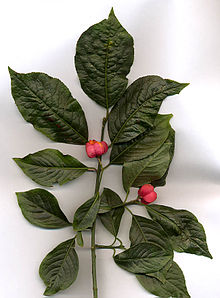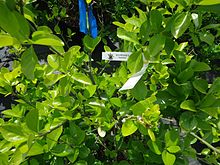Euonymus
| Euonymus | |
|---|---|

| |
| Euonymus europaeus foliage and fruit | |
| Scientific classification | |
| Kingdom: | Plantae |
| Clade: | Tracheophytes |
| Clade: | Angiosperms |
| Clade: | Eudicots |
| Clade: | Rosids |
| Order: | Celastrales |
| Family: | Celastraceae |
| Genus: | Euonymus L.[1] |
| Diversity | |
| c. 140 species | |
| Synonyms[1] | |
| |
Euonymus /juːˈɒnɪməs/ is a genus of flowering plants in the staff vine family Celastraceae. Common names vary widely among different species and between different English-speaking countries, but include spindle (or spindle tree), burning-bush, strawberry-bush, wahoo, wintercreeper, or simply euonymus. It has about 140 species[1][2][3] of deciduous and evergreen shrubs, small trees and lianas. They are mostly native to East Asia, extending to the Himalayas,[4] and they are also distributed in Europe, Australasia, North America, and Madagascar. Fifty species are endemic to China.[2]
Description
[edit]The inconspicuous flowers occur in small groups, and can be green, yellow, pink or maroon in color depending on species.[4] The leaves are opposite (rarely alternate) and simple ovoid, typically 2–15 cm long, and usually with a finely serrated margin. The fruit is a pink or white four- or five-valved pod-like berry, which splits open to reveal the fleshy-coated orange or red seeds.
The seeds are eaten by frugivorous birds, which digest the fleshy seed coat and disperse the seeds in their droppings. Many species are used in traditional medicines, and parts of the plants can be poisonous to humans.[5]
Cultivation and uses
[edit]
The wood of some species was traditionally used to make spindles for spinning wool;[6] this use is the origin of the British English name of the shrubs.
Euonymus are popular garden shrubs, grown for their foliage, the deciduous species often exhibiting very bright red autumnal colours, and also for the decorative berries. Euonymus alatus (winged euonymus or burning-bush) is considered an invasive species in the woodlands of the northeastern United States.
Selected species
[edit]

- Euonymus acanthocarpus
- Euonymus acuminifolius
- Euonymus alatus – winged spindle, burning-bush
- Euonymus americanus – strawberry-bush
- Euonymus angulatus
- Euonymus atropurpureus – eastern burning-bush, eastern wahoo
- Euonymus castaneifolius
- Euonymus carnosus
- Euonymus cochinchinensis
- Euonymus cornutus
- Euonymus dichotomus
- Euonymus dielsianus
- Euonymus europaeus – European spindle
- Euonymus fimbriatus – fringed spindle tree
- Euonymus fortunei – Fortune's spindle, wintercreeper
- Euonymus frigidus
- Euonymus glandulosus
- Euonymus grandiflorus
- Euonymus hamiltonianus – Hamilton's spindle, Himalayan spindle, Siebold's spindle[7]
- Euonymus indicus
- Euonymus japonicus – Japanese spindle, evergreen spindle
- Euonymus lanceifolia
- Euonymus laxiflorus
- Euonymus lucidus
- Euonymus macropterus
- Euonymus morrisonensis
- Euonymus myrianthus – many-flowered spindle
- Euonymus nanus – dwarf spindle
- Euonymus obovatus – running strawberry-bush
- Euonymus occidentalis – western burning-bush
- Euonymus oxyphyllus – Korean spindletree[8]
- Euonymus phellomanus
- Euonymus sachalinensis
- Euonymus sanguineus – blood red spindle
- Euonymus serratifolius
- Euonymus verrucosus
- Euonymus walkeri
- Euonymus wilsonii – Chinese euonymus
References
[edit]- ^ a b c "Euonymus L." Plants of the World Online. Royal Botanic Gardens, Kew. Retrieved 8 October 2024.
- ^ a b Euonymus. Flora of China.
- ^ Du, C., et al. (2013). Revision of three species of Euonymus (Celastraceae) from China. Phytotaxa 109(1) 45-53.
- ^ a b Botanica: The Illustrated A-Z of over 10000 Garden Plants and How to Cultivate Them. Könemann, 2004. pg. 358. ISBN 3-8331-1253-0
- ^ Plants for a Future: Euonymus europaeus
- ^ Clapham, A. R. (1975). The Oxford Book of Trees. Oxford: Oxford University Press. p.31.
- ^ Siebold's spindle, iNaturalist
- ^ English Names for Korean Native Plants (PDF). Pocheon: Korea National Arboretum. 2015. p. 463. ISBN 978-89-97450-98-5. Archived from the original (PDF) on 25 May 2017. Retrieved 24 December 2016 – via Korea Forest Service.
